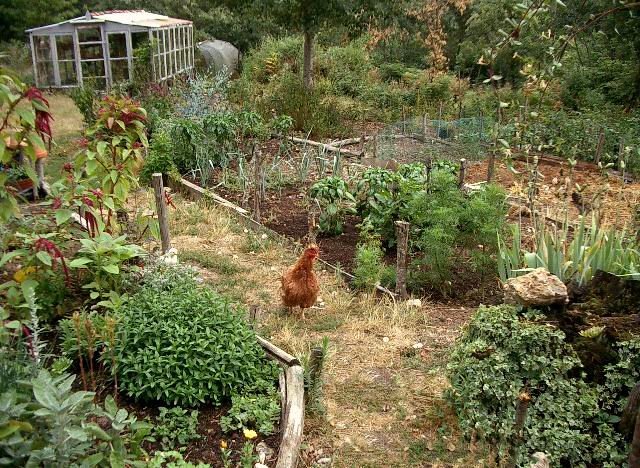Now Reading: How to Create a Permaculture Garden for Sustainability
-
01
How to Create a Permaculture Garden for Sustainability

How to Create a Permaculture Garden for Sustainability
Imagine stepping out into your backyard and being greeted by a lush oasis, where vibrant vegetables, aromatic herbs, and colorful flowers create a harmonious tapestry. A permaculture garden can transform your once-ordinary patch of grass into a self-sustaining ecosystem that not only provides an abundance of food and beauty but also nurtures the environment. Whether you’re a seasoned gardener looking to revitalize your backyard or a beginner exploring the world of sustainable living, this article will guide you through the process of creating a permaculture garden that will serve as a model of sustainability for years to come. Let’s dig in and delve into the fascinating world of permaculture gardening!
Table of Contents
- Understanding Permaculture Principles
- Selecting the Right Location for Your Permaculture Garden
- Designing and Implementing Sustainable Water Systems
- Choosing the Ideal Plant Species for a Thriving Permaculture Garden
- Maintaining Organic Soil Health in a Permaculture Garden
- Q&A
- The Conclusion

Understanding Permaculture Principles
Permaculture principles serve as a guiding framework for creating sustainable and harmonious ecosystems. By understanding these principles, individuals can design and maintain their spaces in a way that works in alignment with nature’s patterns and processes.
1. Observe and interact: Permaculture encourages active observation of our surroundings, allowing us to gain insights into the natural flow of energy, water, and resources. By understanding these patterns, we can better interact with them and create systems that work symbiotically with nature.
2. Use and value renewable resources and services: Permaculture emphasizes the importance of utilizing resources that can be replenished naturally over time. By valuing renewable resources, such as solar energy or rainwater, we reduce our dependence on unsustainable practices and contribute to the long-term health of our planet.
3. Integrate rather than segregate: In permaculture, the focus is on creating interconnected systems instead of isolated components. By integrating various elements, such as plants, animals, and structures, we can create mutually beneficial relationships that enhance overall productivity and resilience.
4. Embrace diversity: Biodiversity is not only vital for a healthy ecosystem but also for the resilience of our designs. Permaculture encourages the cultivation of diverse plant and animal species, enabling a wider range of interactions and increasing the system’s ability to adapt to different conditions.
5. Value the edges and boundaries: In nature, edges and boundaries are often the most productive and diverse areas. Permaculture recognizes the potential for innovation and abundance at these transition zones, and encourages their careful design and optimization.
Remember, permaculture principles are not rigid rules, but rather flexible guidelines that can be adapted to different contexts and landscapes. By understanding and applying these principles, we can create sustainable and regenerative systems that not only benefit us but also support the natural world.
Selecting the Right Location for Your Permaculture Garden
When it comes to establishing a successful permaculture garden, choosing the right location is key. Ideally, you want a spot that receives ample sunlight throughout the day, ensuring your plants can thrive and photosynthesize. Before you begin digging, take the time to assess your potential garden sites and consider the following factors:
- Access to Sunlight: Find an area in your yard that receives at least six hours of direct sunlight daily. Remember, different plants have different sunlight requirements, so plan your garden layout accordingly.
- Soil Quality: Conduct a soil test to assess its composition, pH levels, and nutrient content. Look for loamy soil, which is ideal for most plants. If your soil is heavy clay or sandy, consider amending it with organic matter to improve its quality.
- Drainage: Ensure that your chosen location has proper drainage to prevent waterlogging. Avoid areas prone to standing water, as it can lead to root rot and other plant diseases.
- Proximity to Water Source: Having a water source nearby makes it more convenient to water your garden regularly. Consider installing rain barrels or utilizing a nearby irrigation system for a sustainable water supply.
- Protection from Wind: Strong winds can damage delicate plants and disrupt pollination. To shield your garden, consider planting windbreakers such as tall trees or constructing a fence to create a microclimate.
By carefully selecting a location that meets these criteria, you will provide your permaculture garden with the best chance for success. Remember, each garden is unique, so don’t be afraid to experiment and adjust based on the specific needs of your plants and the characteristics of your space.
Designing and Implementing Sustainable Water Systems
When it comes to , there are several innovative approaches that can ensure the long-term availability and conservation of this precious resource. One of the key considerations is the integration of eco-friendly technologies and practices to minimize water wastage and maximize efficiency.
Here are some essential steps to follow:
- Conduct a comprehensive water audit: Before embarking on any water system design, it is crucial to assess the existing water consumption patterns and identify potential areas for improvement. This audit can help determine the specific requirements and guide the design process towards efficiency.
- Implement rainwater harvesting: The collection and utilization of rainwater can significantly reduce reliance on traditional water sources. Incorporating rainwater harvesting systems, such as rooftop collection and storage tanks, can help alleviate pressure on municipal supplies and promote sustainable water usage.
- Promote water recycling and reuse: Treating and reusing wastewater for non-potable purposes, such as irrigation or industrial processes, can conserve water and reduce strain on freshwater reserves. Implementing advanced water treatment technologies and establishing reuse policies are critical for achieving sustainable water systems.
- Encourage community participation: Designing sustainable water systems goes beyond technical solutions; it requires active involvement from all stakeholders. Engaging the local community in water conservation initiatives, education programs, and awareness campaigns can foster a culture of responsible water management and ensure the long-term success of the system.
is a multi-faceted task that requires careful planning, innovative thinking, and a commitment to preserving this vital resource for future generations. By following these steps and incorporating eco-friendly practices, we can pave the way for a more water-resilient and environmentally conscious future.
Choosing the Ideal Plant Species for a Thriving Permaculture Garden
When it comes to creating a permaculture garden, the choice of plant species is crucial for achieving a thriving and sustainable ecosystem. Here are some key factors to consider when selecting the ideal plants:
- Native Species: Opt for plants that are indigenous to your region as they are naturally adapted to the local climate and soil conditions. This not only enhances their chances of survival but also promotes biodiversity.
- Companion Planting: Harness the power of nature by strategically pairing plants that benefit each other. For instance, planting marigolds alongside tomatoes can deter harmful pests, while beans provide nitrogen to neighboring plants through their symbiotic relationship with soil-dwelling bacteria.
- Polyculture: Embrace diversity by cultivating a variety of plant species that complement each other. Mixing crops with different growth habits, rooting depths, and nutrient requirements helps maximize space utilization and prevents the spread of diseases and pests.
- Perennial Plants: Including perennial species in your garden ensures a long-lasting and low-maintenance ecosystem. These resilient plants return year after year, reducing the need for replanting and allowing for better soil structure development.
- Edible Landscaping: Why not make your permaculture garden both functional and beautiful by incorporating edible plants into the landscape? Fruit trees, herbs, and vegetable patches can provide a continuous supply of nutritious food, making the garden as practical as it is visually appealing.
Remember, the success of a permaculture garden lies in the thoughtful selection of plant species that work together harmoniously. By considering factors such as native species, companion planting, polyculture, perennial plants, and edible landscaping, you can create an oasis that thrives with minimal intervention, while also contributing to the overall health of the environment.
Maintaining Organic Soil Health in a Permaculture Garden
Creating and maintaining a healthy soil ecosystem is the foundation of a successful permaculture garden. By focusing on organic soil practices, you can cultivate an environment that supports the growth of vibrant plants while minimizing the need for synthetic fertilizers or harmful pesticides. Here are some key guidelines to help you maintain organic soil health in your permaculture garden:
- Compost, compost, compost: The backbone of organic soil health lies in the rich, nutrient-dense compost you create. Regularly incorporate compost into your garden beds to enhance soil structure, improve water retention, and provide essential nutrients for your plants. Experiment with different composting techniques such as worm composting or hot composting to find what works best for your garden.
- Cover crops and green manure: Consider sowing cover crops or planting green manure to enhance soil fertility during periods of rest. These plants help protect the soil from erosion, fix nitrogen, and increase organic matter when they are eventually turned back into the soil. Examples of cover crops include legumes like clover or vetch, which offer a double benefit of enriching the soil with nitrogen.
- Mulching to retain moisture: Apply a layer of organic mulch, such as straw, wood chips, or shredded leaves, to your garden beds. Mulching not only helps retain moisture levels in the soil, reducing water needs over time, but it also suppresses weeds and improves soil temperature stability. Be sure to replenish mulch regularly as it breaks down and use appropriate materials for the needs of each plant.
By following these practices, you can create a self-sustaining soil ecosystem that fosters thriving plants and minimizes the need for external inputs. Remember, healthy soil is the key to a flourishing permaculture garden.
Q&A
What is permaculture gardening?
Permaculture gardening is a sustainable approach to designing and maintaining a garden that mimics the patterns and principles found in nature. It aims to create a self-sufficient ecosystem that requires minimal energy input and fosters biodiversity.
Why is permaculture gardening important for sustainability?
Permaculture gardening is important for sustainability as it promotes a harmonious relationship between humans and nature. It reduces the reliance on fossil fuels, encourages organic practices, and helps restore degraded landscapes, leading to a more resilient and sustainable future.
How can I start creating a permaculture garden?
To start creating a permaculture garden, begin by observing your surroundings, understanding the site’s natural features, and identifying the specific needs of your plants. Then, design your garden using permaculture principles like zoning, efficient use of resources, and integration of diverse plant species.
What are the key principles of permaculture gardening?
The key principles of permaculture gardening include observing and interacting with nature, capturing and storing energy, obtaining a yield, applying self-regulation and accepting feedback, using and valuing renewable resources, producing no waste, designing from patterns to details, integrating rather than segregating, using small and slow solutions, and valuing diversity.
Can I implement permaculture practices in a small urban garden?
Absolutely! Permaculture principles and practices can be applied to any size of garden, including small urban spaces. By utilizing containers, vertical gardening techniques, and maximizing every inch of space, you can create a productive and sustainable garden in the heart of the city.
What are some benefits of permaculture gardening?
Permaculture gardening offers numerous benefits, such as reducing water usage through efficient design, increasing biodiversity and soil fertility, minimizing reliance on harmful pesticides and fertilizers, and providing a constant supply of fresh, organic food. It also enhances the overall beauty and resilience of your garden.
How can permaculture gardening contribute to the local community?
Permaculture gardening can contribute to the local community by promoting food security, encouraging sustainable living practices, and fostering a sense of community engagement. It can serve as an educational tool, inspiring others to adopt sustainable gardening methods and creating opportunities for sharing surplus produce with neighbors and local organizations.
Does permaculture gardening require a lot of maintenance?
Initially, permaculture gardening may require some extra effort in terms of setting up the garden and establishing the ecosystem. However, once the garden becomes self-sustaining, it tends to require less maintenance compared to traditional gardening methods. Regular observations and occasional interventions are usually all that is needed to ensure the garden’s success.
The Conclusion
As we bring this journey through the world of permaculture gardening to a close, it’s time to reflect on the power we hold to create a sustainable sanctuary in our own backyards. With every choice we make, every seed we sow, we have the ability to weave together a vibrant tapestry, where nature and humanity coexist in perfect harmony.
In this article, we’ve explored the fundamental principles of permaculture and the ingenious techniques used to design regenerative gardens. By focusing on mimicry, integration, and resilience, we can transform our patches of earth into thriving ecosystems that provide for us while giving back to the planet.
Remember, the journey towards a permaculture garden is one of patience and deep connection. It starts with observing the land, listening to its stories, and understanding its needs. With time, we learn to work with nature, rather than against it, unwrapping its hidden potentials in surprising ways. Through clever plant combinations, water management systems, and biodiversity conservation, we create landscapes that breathe life into our surroundings.
But the true beauty of permaculture gardening lies not only in the countless benefits it bestows upon the Earth, but also in the sense of fulfillment and purpose it brings to our lives. As we tend to our gardens, we become custodians, immersed in a timeless dance with the cycles of nature. We witness the miracle of growth, the resilience of life, and the interconnectedness of every living being.
So, dear reader, take this knowledge and let it root itself deep within your soul. Let it guide your hands as you shape the soil, planting seeds of change in the world around you. And as your permaculture garden takes shape, let it become a testament to the boundless possibilities that lie within our grasp.
In the spirit of sustainability, may we all be inspired to create gardens that not only sustain us, but also inspire the generations to come. Let this be our ode to the magnificent symphony of life, forever in harmony with the Earth.
As an affiliate, my content may feature links to products I personally use and recommend. By taking action, like subscribing or making a purchase, you’ll be supporting my work and fueling my taco cravings at the same time. Win-win, right?
Want to read more? Check out our Affiliate Disclosure page.





